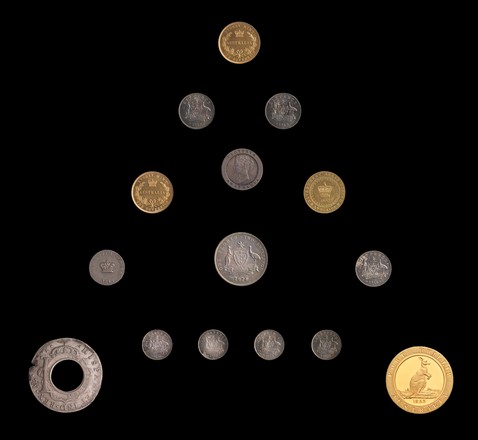
Coins
1850s–1920s
Gold, silver
Bequest of Sir William Dixson, 1952
DN / C 15-16, 290, 414, 419-422, 428-29, 465, 504, 586, 591, 656, 662, 670
Gold, silver
Bequest of Sir William Dixson, 1952
DN / C 15-16, 290, 414, 419-422, 428-29, 465, 504, 586, 591, 656, 662, 670
Many of the coins collected by Sir William Dixson are unique or very rare; many are more humble. As a group, they present a picture of the first 150 years of European settlement in Australia, from the early struggles to establish a functioning settlement and overcome deprivations to the confidence and pride in of a thriving city.
A particular highlight are the holey dollars, with the collection forming the most extensive series in existence. The ‘holey dollar’ was created in an attempt to solve the problem of a shortage of coins in NSW, which the colony inherited from England. The possibility that a convict settlement might require hard currency appears not have been considered, and so in the early years currency was very scarce. Colonists typically paid for goods by bartering or with coins brought from England. With visits of foreign trading vessels, foreign coins were added to the small supply of coins in circulation, but were soon shipped away, since they were current in other parts of the world.
With ingenuity born of desperation, in 1813 the authorities conceived the idea of stamping out the centre off the Spanish dollar coin, removing a piece about the diameter of a five-cent piece. The external portion, the ‘holey dollar’ retained its face value of five shillings in the colony, but was spoiled for circulation elsewhere. The centre portion, called the ‘dump’ was circulated as a new coin, one-quarter of the value of the holey dollar.


 Back to list
Back to list